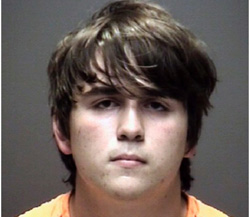
Another school shooting — in Santa Fe, Texas. Ten dead — eight students and two teachers — and 13 wounded.
This one wasn’t like the Parkland, Florida shooting, where everyone knew that the perpetrator, Nikolas Cruz, had serious psychological problems. No, this time, when 17-year-old Dimitrios Pagourtzis opened fire, people were shocked.
There was only one mention of a possible motive mentioned so far. One of the students killed was Shana Fisher, 16. Shana’s mother, Sadie Rodriguez, said that for four months, Pagourtzis kept making advances on her, and she kept refusing. According to the Los Angeles Times,
“Pagourtzis continued to get more aggressive, and she finally stood up to him and embarrassed him in class, Rodriguez said. ‘A week later he opens fire on everyone he didn’t like,’ she wrote. ‘Shana being the first one.’ Rodriguez didn’t say how she knew her daughter was the first victim.”
This statement struck a nerve with me. One of the points that I make in my recent webinar, Why it’s so hard to get over loving a sociopath and how you can recover, is that love is a powerful human motivation. Dr. Helen Fisher, a biological anthropologist who studies love, has found that all love is highly addictive, and being rejected in love can actually makes the passion one feels for the beloved stronger. She points out that people rarely kill over a sexual rejection, but some people do kill over a romantic rejection.
Social dynamics
So I conducted some research to see how often romantic rejection is a factor in school shootings. I found this paper:
Bullying, romantic rejection and conflicts with teachers: The crucial role of social dynamics in the development of school shootings — a systematic review, by Friederike Sommer, Vincenz Leuschner and Herbert Scheihauer, of the Free University of Berlin.
The researchers sought to investigate how often problems with the perpetrators’ social relationships in the school environment were factors in the school shootings. They used the term “social dynamics” to describe various social conflicts.
The researchers found 126 cases, of which 67 included detailed descriptions of how social dynamics contributed to the attacks. Here are their findings:
In 88.1% of cases, the future perpetrator experienced social conflict within the school environment. This included:
- 29.9% who were physically bullied
- 53.7% who experienced peer rejection
- 29.9% who experienced romantic rejection
- 43.3% who experienced conflicts with teachers
In 85.1% of cases, others described the perpetrators as experiencing some degree of social marginalization. For example, in 47.8% of cases, other people described the perpetrators as loners or social outcasts. However, the perpetrators described themselves as loners in only 23.9% of the cases, and in only 55.2% of the cases was there evidence that the perpetrators themselves felt socially marginalized.
So romantic rejection was sometimes a factor, but not always. The same with bullying. There is no particular social dynamic that always, or even usually, leads to school shootings.
Shooter personalities
What about personality disorders? After the school shooting in Parkland, Florida, I wrote the following article:
Florida shooter Nikolas Cruz — psychopath, psychotic or traumatized?
In it, I referred to the work of Dr. Peter Langman. I will reproduce part of the article here:
Peter Langman, Ph.D., is a psychologist who is probably the top expert on the subject. He’s written two books:
School Shooters: Understanding High School, College and Adult Perpetrators
Why Kids Kill: Inside the Minds of School Shooters
Dr. Langman notes that the media and some experts have tried to explain the causes of school shootings as the result of “bullying, violent video games or conventional ideas about masculinity.” But these explanations fall short for obvious reasons: The vast majority of people who endure bullying, play violent video games or are male do not shoot up schools.
Dr. Langman maintains a website called SchoolShooters.info that includes a comprehensive database of 141 perpetrators of violence in educational settings from around the world.
Yes, most of the perpetrators — 119 of them — were in the United States. But Dr. Langman also includes cases in Australia (2), Brazil (2), Canada (7), Finland (2), Germany (7), Scotland (1) and Sweden (1).
Typically, shooters are stereotyped as young, white males, but this isn’t always the case. SchoolShooters.info includes information of nine female perpetrators, 42 male perpetrators who were African American, Asian, Latino, or other races, and 44 perpetrators who were over the age of 25.
Three types of school shooters
Through his research, Dr. Langman has identified three types of school shooters:
- Psychopathic shooters are narcissistic, entitled, lacking in empathy, and sometimes sadistic. Some are abrasive and belligerent; others are charming and deceptive.
- Psychotic shooters have either schizophrenia or schizotypal personality, with a combination of psychotic symptoms (hallucinations, delusions, disorganized thoughts/behavior), eccentric behavior and beliefs, and severely impaired social/emotional functioning.
- Traumatized shooters grew up in chronically dysfunctional families characterized by parental substance abuse, domestic violence, physical abuse, sometimes sexual abuse, frequent relocations, and changing caregivers.
Dr. Langman has also found other factors that contribute to psychological problems. For example, he noted that many perpetrators have “body-related issues.” Many shooters were unusually short. Some had birth defects or major illnesses. Several were physically weak and had no athletic ability. Some had been sexually molested.
Family patterns, Dr. Langman says, may also play a role. He found that many shooters came from families where one or more relatives served in the military or law enforcement. Many of the shooters themselves wanted to join the military, but failed — which may have contributed to their psychological issues.
In short, although there is not one profile that leads to school shootings, there are patterns. If you would like to learn more, I recommend two of Dr. Langman’s papers — both highly readable — that explain the complex issues that lead some people to commit such extreme violence.
A Bio-Psycho-Social Model of School Shooters
Rampage School Shooters: A Typology
Patterns but no prediction
So research in psychology and sociology can discern patterns that correlate with school shootings after the fact. But correlation is not causation, and social situations do not cause school shootings.
The obvious evidence: Many, many students are bullied, rejected and experience conflict with teachers. Many students are also psychopathic, psychotic and traumatized. The vast majority of them do not pick up guns.
In the absence of clear warning signs, like those exhibited by Nikolas Cruz, psychology and sociology, are not going to prevent a particular individual from shooting up a school. Laws and policies aren’t foolproof either. As all of us who have dealt with sociopaths know, disordered people do not believe that laws apply to them. If an angry, impulsive or disordered teenager is determined to get a gun, there’s a good chance that laws won’t prevent it.
Solutions for safety
The most effective solution is probably to construct the schools buildings to be safe in the first place. I’ve seen some interesting ideas in recent news articles.
Schools rethink building design to protect students from mass shooters, on MarketWatch.com.
This article suggests:
- Building schools on raised ground, so employees can easily see people who are making their way to the campus.
- Layers of zoning and locked doors — hallways and entrances are being designed so teachers can easily spot who is moving around a school.
- Install safe rooms — made of concrete and locked from the inside. They also function as tornado shelters.
- Schools should have a single main entrance that is monitored by administrators. Additional exits for safety purposes should be alarmed and only able to be opened from the inside.
Designing a school to stop shooters, on WSJ.com:
This article describes a new school built in Texas — unfortunately not in Santa Fe.
Sparse landscaping and numerous windows in front provide a clear view of approaching visitors. Entry is a multistep process. Visitors enter a vestibule and must be buzzed inside the main office. From there, a government-issued ID must be scanned through a system called the “Raptor,” which alerts for child molesters and anyone flagged to keep out.
Wide hallways devoid of nooks make it harder to hide or avoid video surveillance that is viewable by school administrators as well as police officers in patrol cars.
Building new schools is, of course, expensive and will take time. In the meantime, it seems to me that schools should have limited, secured entrances. And everyone going into school through the secured entrance should pass through a metal detector and have their bags searched.
We do it at airports, concerts and sporting events. Why can’t we do it at schools?




































